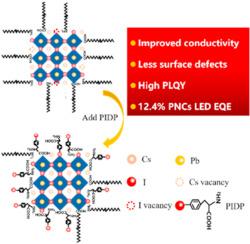Materials Today Physics ( IF 10.0 ) Pub Date : 2021-10-19 , DOI: 10.1016/j.mtphys.2021.100555 Chengyuan Tang 1 , Xinyu Shen 1 , Siyao Yu 1 , Yuan Zhong 1 , Zhenyu Wang 1 , Junhua Hu 2 , Min Lu 1 , Zhennan Wu 1 , Yu Zhang 1 , William W. Yu 3 , Xue Bai 1

|
Inorganic CsPbX3 (X = Cl, Br, I) perovskite nanocrystals (PNCs) have a great promise for LED applications due to their high brightness and tunable emission. However, the long chain capping ligands such as oleylamine and oleic acid function are electrically insulating layers to hinder the charge carrier injection and transport, limiting the device performances. To overcome the limitations, p-iodo-D-phenylalanine (PIDP) was used in the post-treatment process of PNCs to partially substitute the long insulating ligands to improve the conductivity of CsPbI3 PNC films. Besides, the surface defects were also passivated by PIDP, increasing the radiative decay rate and decreasing the non-radiative decay rate, thus enhanced the photoluminescence quantum yield of the PNCs. As a result, highly efficient PNC LEDs were obtained with an external quantum efficiency of 12.4% and a peak luminance of 2000 cd m−2.
中文翻译:

p-碘-D-苯丙氨酸对CsPbI3纳米晶体的后处理用于高效钙钛矿LED
无机 CsPbX 3 (X = Cl, Br, I) 钙钛矿纳米晶体 (PNC) 由于其高亮度和可调发射而在 LED 应用中具有广阔的前景。然而,油胺和油酸等长链封端配体是电绝缘层,阻碍了电荷载流子的注入和传输,限制了器件的性能。为了克服这些限制,在PNCs的后处理过程中使用p -iodo-D-苯丙氨酸(PIDP)来部分替代长绝缘配体以提高CsPbI 3的电导率PNC 电影。此外,表面缺陷也被PIDP钝化,增加了辐射衰减率并降低了非辐射衰减率,从而提高了PNCs的光致发光量子产率。结果,获得了具有12.4%的外部量子效率和2000 cd m -2的峰值亮度的高效PNC LED 。











































 京公网安备 11010802027423号
京公网安备 11010802027423号